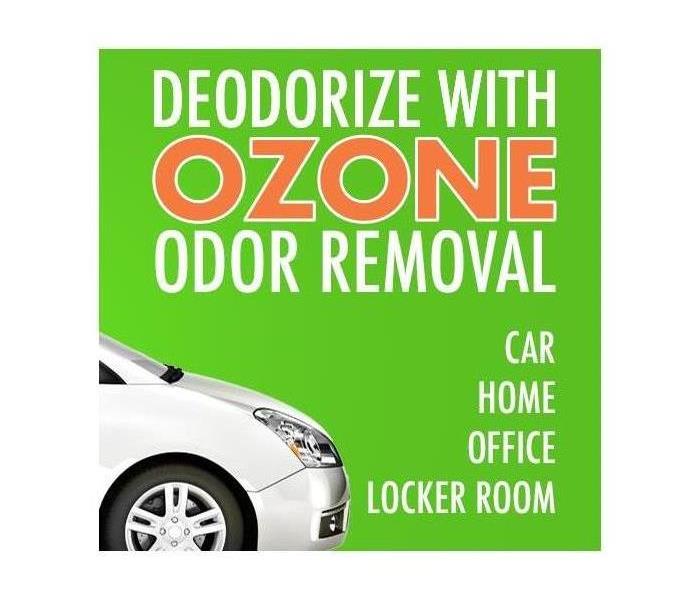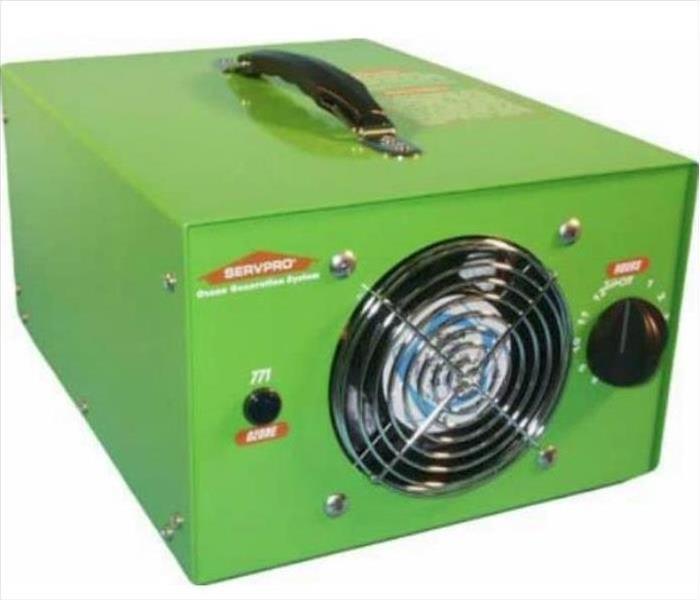Recent Cleaning Posts
Do you Have a Stubborn odor that Cannot be Removed?
4/4/2022 (Permalink)
 Whether it’s a smoky smell in a vehicle, or a locker room full of stinky equipment, we’ve got odor solutions for any size job.
Whether it’s a smoky smell in a vehicle, or a locker room full of stinky equipment, we’ve got odor solutions for any size job.
The science of identifying and eliminating odors can be tricky, but as pros in deodorization, we're able to take care of it.
SERVPRO of Farmington and Farmington Hills can help identify and remove the odor. We have several odor removal products to help remove offensive odors. One technique used for stubborn odors is an Ozone generator to destroy stubborn odors, such as tobacco, soot, animal, and mildew odors. Many deodorizers simply mask odors, but an Ozone generator can remove the odor.
How does an Ozone generator work?
Ozone reacts to the odors through an oxidation process to change the molecular structure.
Are there dangers when using an Ozone generator?
The area being treated by an Ozone generator must be free from humans, pets, and plants. The treated space must then be circulated with fresh air before people and pets can go in.
An Ozone generator can be a safe and effective tool to remove stubborn odors. Our technicians are highly trained with years of experience, call SERVPRO of Lansdale, Warminster, Blue Bell and Abington Jenkintown at 215.368.4110 to safely eliminate odors from your home or business.
Deodorization Techniques
4/5/2021 (Permalink)
 The picture above is one of our ozone machines. This machine can help make that odor "Like it never even happened."
The picture above is one of our ozone machines. This machine can help make that odor "Like it never even happened."
People often use masking agents such as air fresheners and candles in an attempt to eliminate a smell. While these methods may do a decent job of masking the odor they are temporary solutions. The offensive odors noses pick up is a result of volatile molecules. These molecules are in compounds or chemicals that evaporate very quickly. As a result, they stream through the air and end up in the nose.
There’s a science to removing smells. Humans have a highly sensitive olfactory and the human nose contains millions of sensory neurons. Malodors send subliminal messages about a space that silently screams, this place is unclean!
Some of the top offensive odors include:
- Cooking odors
- Mold and/or mildew odors
- Pet urine or feces
- Tobacco smoke
- Fire and smoke damage odors
Your local SERVPRO® offers cleaning options that do more than just make your home temporarily smell good. Our professional and certified technicians use state of the art HEPA filters, air scrubbers, and deodorization techniques that will ensure a long lasting deep clean long after the crew leaves the premises. High volume trafficked areas are notorious for lingering smells. Commercial areas such as:
- Restaurants
- Apartment communities
- Retirement homes
- Community centers
Can be cleaned by our certified technicians to restore your property with a pleasant aroma. We also offer deodorization treatments to residential customers and this can be combined with a carpet and or duct cleaning for a new home smell.
Top 3 Deodorization Treatment Techniques
Absorbents. This type of treatment is good for confined spaces, air ducts, and filters.
Neutralization. An equalizing chemical neutralizes stinky odors
Biocides. Another type of chemical process but this one kills or greatly reduces growth of microorganisms.
Ozone machines are another way to clean the air. They work by attacking ozone molecules and pollutants at their source to oxidize the air.
SERVPRO® of Lansdale, Warminster, Blue Bell, and Abington Jenkintown has the training, experience, and equipment to make it “Like it never even happened.” And to make your house feel like a home again.
Keeping Your Drapes Odor Free
4/8/2020 (Permalink)
 Keep you drapes odor free!
Keep you drapes odor free!
Dirty draperies can make the entire room smell dingy and look unattractive. No one wants to deal with unpleasant odors; cleaning and deodorizing your drapes regularly can go a long way to making a space fresh, pleasant, and appealing.
Just removing your drapes from the curtain rod and putting them into your washing machine can be very effective if they are made of cotton or polyester blends, but some textiles, such as velvet, silk, taffeta, chenille, and brocade, simply can’t be safely cleaned by that method. These types draperies will have to be dry cleaned, as well as sheers and those that are insulated or lined. The care of a professional might be needed to remove spots and unsightly stains, as well.
Before you undertake this project, take a look at the care instructions for your draperies, usually located on a tag inside. These instructions will let you know how the material should be cared for, with specifics as to water temperature, the type of cleaning solutions that will be safe, and what the dryer setting will need to be. It might even be necessary to air dry them.
Over time, drapes will collect dust and grime just from hanging in a room. They will collect odors as well, and the smell can affect the entire room. A proper cleaning, whether DIY or professional, with restore your rooms to their normal sweet, odor-free state.
If you decide to do it yourself, you will want to start with a good vacuuming! It’s not necessary to take them down if you can reach them properly. After the vacuum cleaning, a hand-held steamer will work nicely to give them a fresh look and scent. Before steaming, you will want to be sure that the cleaning instructions don’t advise against it. Those that can be machine washed will be taken down and washed and dried; make sure you remove them from the dryer immediately to alleviate wrinkles.
After your draperies have been cleaned and re-hung, you can lightly spray them with linen spray, if their care allows. This will add a lovely scent to the room, and definitely deodorize them to keep any bad odors from hanging around.
The Difference in Hardwood Floor Cleaners
4/11/2019 (Permalink)
Hardwood floors are hailed for their natural beauty, but they require varying degrees of attention to maintain these good looks, depending on the finish. Floors with penetrating finishes (that soak into the wood) and wax top coats (which protect the finish) can be quite a chore to maintain because they easily absorb water and require solvent-based cleansers only—one reason many people opt for surface-sealed wood floors instead. These other hardwood floors all have polyurethane, urethane, or other finishes to form a protective waterproof barrier and protect from light scratches and dents, and their regular cleaning is much easier to get right because of the wider variety of cleansers that can be used
What Makes a Great Hardwood Floor Cleaner?
Factor in these features as you read labels of hardwood floor cleaners.
Gentle ingredients. Look for non-corrosive ingredients like water, weak acids such as citric acid or hydrogen peroxide, or weak bases such as sodium bicarbonate. Avoid products containing strong acids or bases, such as nitric acid or sodium hydroxide, which can strip the finish of surface-sealed floors. Also avoid hardwood floor cleaners containing oil, which can leave a sticky residue, or wax, which can dull the floor finish and leave it slippery.
Concentration. You’ll find hardwood floor cleaners in one of two formulations:
Complete hardwood floor cleaners can be applied to the floor straight out of the bottle because they contain all the necessary ingredients pre-mixed. They minimize overall time and effort, so great for everyday or last-minute cleaning jobs. Floor cleaner concentrate products contain a potent cleaning fluid that must be diluted in water specified per product instructions before use. While they take more time to prepare, they let you adjust the potency (and pungency) by adding more or less water.
Convenient packaging. Hardwood floor cleaner is sold in three types of packaging:
Spray bottles feature a built-in trigger that dispenses a fine mist of cleaning solution onto the floor. You then either wipe down or mop the floor, which makes this packaging option good for spot cleaning or cleaning small areas.
Squirt bottles dispense a small pool of cleaner onto the floor, which can then be mopped. This option is versatile enough to use on small or large floor areas.
Refill bottles contain larger quantities, which you can pour into either a spray bottle or the fluid cartridge of a reusable spray mop. Avoid pouring cleaner from refill bottles directly onto the floor, because it’s easy to accidentally dispense more than intended—potentially causing floors to absorb the fluid and swell. This is the best option for larger cleaning jobs of one or more floors.
Please consider these recommendations when choosing a hardwood floor cleaner. If you don't feel up for the task. SERVPRO of Lansdale, Warminster, and Blue Bell are here to help.
DIY Spring Cleaning Tips
4/11/2018 (Permalink)
Spring has arrived – which means it’s time to get your home in tip-top shape. A good, deep spring clean-up is a tradition that not only promotes wellness by keeping your environment clean and organized; it also helps carry the fresh-start feeling brought on by a new year well into the summer.
We’ve compiled some of the best DIY spring cleaning tips so you can deep clean your house and make it sparkle all year round.
Spring cleaning tips
Remove water stains with lemon for a natural faucet fix
This spring, make faucets clean and sparkly by rubbing a lemon half on the water stains. The citric acid helps remove hard water marks. Then, use the other half of the lemon for our next tip.
Clean your microwave by heating lemon juice and rinds in water
Cut a lemon into halves, squeeze the juice into 1/2 cup of water and drop the rinds into the mixture. Microwave for three minutes and let it stand for five minutes without opening the door. The trapped steam will loosen the grime, so you can wipe the microwave clean with less elbow grease.
Use white vinegar to beat shower head buildup
Looking for more natural ways to clean your bathroom? Vinegar can dissolve the mineral deposits accumulate in showerheads over time, causing reduced pressure and water flow. Fill a plastic bag with white vinegar, secure it over the showerhead with a rubber band and leave it overnight to get rid of buildup. Just be sure to run the shower before you hop in, or you risk smelling like vinegar all day.
Clean stainless steel sinks with baking soda
Simply wet your sink and faucet, sprinkle baking soda, and scrub with a sponge. If you need more heavy-duty scrubbing power, add salt to the baking soda.
Organize your fridge and cabinets with rotating turntables
Don’t limit rotating turntables and Lazy Susans to your tabletops. After discarding old condiments and spices, organize your pantries and refrigerator with this useful storage hack.
Place a wet dryer sheet on your ceramic stovetop to remove burnt-on residue
Dryer sheets are non-abrasive and a great way to remove burnt-on food from your stove. Place the wet dryer sheet on your stovetop at least 15 minutes before rubbing the gunk away.
Clean your grill with an onion.
Get your grill cleaned up and ready for the warm weather. First, heat it up and spray some white vinegar onto the grates to help loosen the residue. Then, scrub the area firmly using half an onion. The acid from the onion will rid your grill of any leftover remnants.
SERVPRO of Lansdale is "Ready For Any Size Disaster" 215.368.4110
 Whether it’s a smoky smell in a vehicle, or a locker room full of stinky equipment, we’ve got odor solutions for any size job.
Whether it’s a smoky smell in a vehicle, or a locker room full of stinky equipment, we’ve got odor solutions for any size job.






 24/7 Emergency Service
24/7 Emergency Service
